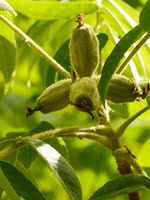Mon-Fri 9am - 5pm Mountain time
American Elm vs Butternut (White Walnut)
Ulmus americana
Juglans cinerea
American Elm is fast growing, tall tree with a recognizable and pleasing shape.
It's well suited for urban environments because of its non-invasive roots and ability to grow on harsh sites (quite salt tolerant). American Elm develops a wide, dense canopy that provides shade for many city streets around North America.
Butternut is one of the few walnut varieties native to Canada. The nuts are sought after for their mild, sweet, and oily taste. Ensure this tree is planted in full sun and well-drained soil for best results.
Butternut is self-fertile but it has better yields when planted near other butternuts. It can survive in zone 2, but reliably produces nuts in zone 3.
A top CO2 absorbing species. Experts think this tree may help climate change more than others.

